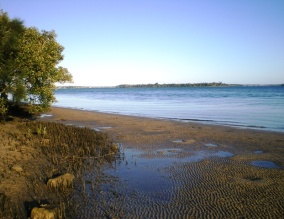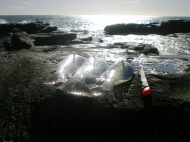Bribie Island – Whitepatch – 29 August 2010
The advantage of fishing from the shore is that provided you are prepared to wrap up, you can still fish in a 15 knot wind. Especially if you chose somewhere like the Pumicestone Passage which has a few, fairly sheltered areas. The other advantage of fishing at these times is there is almost zero boat traffic. All the wise boaties are tucked up in bed having lie in or just listening to Nugget’s fishing show and cursing the weather gods. I am not sure that I subscribe to the idea that there are less fish around in the estuaries than there were 20 years ago – but I do believe the massive increase in boat traffic and other noise and disturbance, has a big effect on our ability to find and catch the fish that are there.
On Sunday morning there was plenty of wind forecast but when I arrived at Whitepatch on Bribie Island, the water was reasonably calm. It was about 5.15 am and the wind had dropped away as the sun was about to come up. This hour around dawn nearly always produces slightly calmer weather. It was just on low tide and I started fishing on the slack water with virtually no tidal flow. I often find this is a slow time. I presume the fish are beginning to reposition themselves and are slightly confused as to where to lie in wait to ambush prey. Sunday was no exception and nothing of note happened until about 45 minutes later when the tide really started running in.
I was fishing a 3” GULP Minnow soft plastic lure in the Banana Prawn colour on a 1/6th 1 jighead. This is another great lure for bream but will tempt almost anything. There is a sizeable drop off all along the shoreline at Whitepatch – it is perfect to fish for about two hours either side of low tide. I had parked at the last car park before the entrance to the Bribie National Park and I was wading south, along the shore, casting up into the run in tide. I caught a few Pike and then a tiny Moses Perch and then I got a touch, a pause, another touch and then bang – the blistering run and head shakes that had to be a Snapper. Over the course of each year, in this spot, I catch perhaps two or three legal size snapper and many more just undersize. Unfortunately this one was in the latter category. He measured up at 28cm and I threw him back, after a quick mug shot. What is uncanny is the consistent way I get these fish when the start of the run in tide coincides with dawn.
I switched to a 2” GULP Shrimp plastic, also in the Banana Prawn colour. I was fishing with about a metre and a half of 10lb fluorocarbon leader, tied onto a spool of 1.8kg Fireline. About 40 minutes after catching the Snapper, I found a patch of Bream. I caught three fish in quick succession. The largest was approximately 30 cm long. Shortly afterwards I reached a large drain with weed beds on either side. These were now covered by approximately a metre of water. I cast out, methodically in a semicircle and caught several Pike and then a very small (25cm) Flathead. I moved on and about 30 minutes later reached a similar drain. I used the same tactics and was rewarded with another Flathead that was just on 40cm. Like all the other fish, I released it. By 9.30 am the water was now effectively too high to continue fishing over the edge of the drop off and the wind was steadily building, so gave up for the day.





























